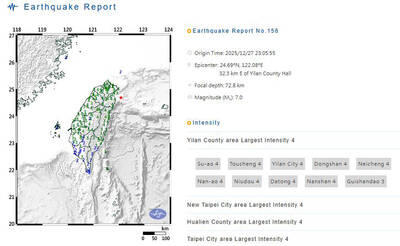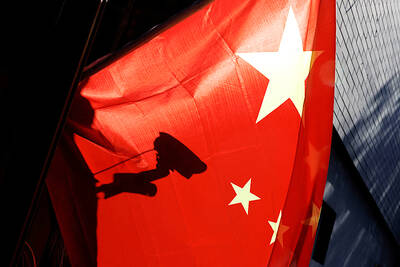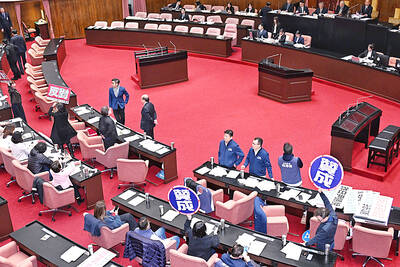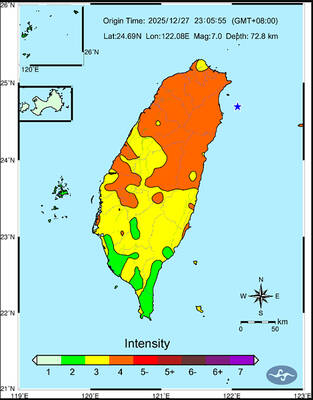US President Barack Obama’s administration has released a new national security strategy calling for “continued reduction in tension” across the Taiwan Strait.
The document emphasizes diplomacy over military action throughout the world and strongly promotes cooperation with China.
Analysts have noted the stark differences between the new strategy and the policies of former US president George W. Bush which were much more strident, with the BBC saying that the new strategy is seen as “a formal break from the go-it-alone Bush era.”
On China, the document says, “We will monitor China’s military modernization program and prepare accordingly to ensure that US interests and allies, regionally and globally, are not negatively affected. More broadly, we will encourage China to make choices that contribute to peace, security, and prosperity as its influence rises.”
COMMUNICATION
“We are using our newly established Strategic and Economic Dialogue to address a broader range of issues, and improve communication between our militaries in order to reduce mistrust,” the document says.
“We will encourage continued reduction in tension between the People’s Republic of China and Taiwan,” it says.
The new strategy acknowledges that the US and China will not agree on every issue.
“We will be candid on our human rights concerns and areas where we differ,” it says. “Disagreements should not prevent cooperation on issues of mutual interest, because a pragmatic and effective relationship between the United States and China is essential to address the major challenges of the 21st century.”
US Secretary of State Hillary Rodham Clinton, speaking at the Brookings Institution in Washington after the document was released, said that too often in the past there had been a “dismissal of dialogue.”
“I think that deepening our engagement with key countries like Russia, China, India and others gives us and our counterparts a better understanding,” she said. “It also puts the relationship on a broader framework than just the usual hotspot, crisis, emergency that then marshals everybody’s attention.”
“We have seen how just in this last year, using dialogue has helped to address some serious common problems, but it has also helped to keep the relationship on an even keel going forward,” she said.
MORE EXCHANGES
The Obama administration, she said, had built on the work of prior administrations with respect to China, and now had “probably the biggest exchange of government officials and sharing of insights that we have ever had, not only with China, but probably with any country,” Clinton said.
She said that the US took more than 200 US government officials to Beijing for the second round of the Strategic and Economic Dialogue and that while a lot of the work that was done would never get into a headline, it was significant.
“Two quick examples: We signed the first-ever agreement where American experts will work with their Chinese counterparts in developing the natural gas industry in China,” she said. “Why is that important? Well, for China, having indigenous, independent energy sources is good news for them; for us, having China have indigenous, independent energy sources is good news for us. Because we see then a shift away from energy dependence in parts of the world that obviously influence their foreign policy.
“Secondly, we did a lot of talking about development,” she said.
“China is present very heavily in Africa, in Latin America and other parts of Asia doing development work, much of it tied to economic interests, but not exclusively. And we actually began to have a conversation for the first time about how we can better understand what they’re doing, be more transparent with what we’re doing, and look for ways to work together,
she said.
National Security Adviser General James Jones said at a press briefing that greater interconnection throughout the world would come with “extraordinary promise” and reinforce many of the US’ “innate strengths, our openness, our diversity, our dynamism, our ingenuity and our dedication to our goals and aspirations.”
“But this interconnection also comes with the perils of global challenges that do not respect borders — global networks of terrorists and criminals, threats in space and cyberspace, the degrading climate and technologies with increasing destructive power,” he said.
“The international architecture of the 20th century, designed for another time, is buckling under the weight of these new threats. As a consequence, it has been difficult to forge the cooperative approach,” he said. “But this new strategy recognizes the changes required in order to be successful in the new environment of the 21st century. And that is the world that we seek.”

A magnitude 7.0 earthquake struck off Yilan at 11:05pm yesterday, the Central Weather Administration (CWA) said. The epicenter was located at sea, about 32.3km east of Yilan County Hall, at a depth of 72.8km, CWA data showed There were no immediate reports of damage. The intensity of the quake, which gauges the actual effect of a seismic event, measured 4 in Yilan County area on Taiwan’s seven-tier intensity scale, the data showed. It measured 4 in other parts of eastern, northern and central Taiwan as well as Tainan, and 3 in Kaohsiung and Pingtung County, and 2 in Lienchiang and Penghu counties and 1

FOREIGN INTERFERENCE: Beijing would likely intensify public opinion warfare in next year’s local elections to prevent Lai from getting re-elected, the ‘Yomiuri Shimbun’ said Internal documents from a Chinese artificial intelligence (AI) company indicated that China has been using the technology to intervene in foreign elections, including propaganda targeting Taiwan’s local elections next year and presidential elections in 2028, a Japanese newspaper reported yesterday. The Institute of National Security of Vanderbilt University obtained nearly 400 pages of documents from GoLaxy, a company with ties to the Chinese government, and found evidence that it had apparently deployed sophisticated, AI-driven propaganda campaigns in Hong Kong and Taiwan to shape public opinion, the Yomiuri Shimbun reported. GoLaxy provides insights, situation analysis and public opinion-shaping technology by conducting network surveillance

‘POLITICAL GAME’: DPP lawmakers said the motion would not meet the legislative threshold needed, and accused the KMT and the TPP of trivializing the Constitution The Legislative Yuan yesterday approved a motion to initiate impeachment proceedings against President William Lai (賴清德), saying he had undermined Taiwan’s constitutional order and democracy. The motion was approved 61-50 by lawmakers from the main opposition Chinese Nationalist Party (KMT) and the smaller Taiwan People’s Party (TPP), who together hold a legislative majority. Under the motion, a roll call vote for impeachment would be held on May 19 next year, after various hearings are held and Lai is given the chance to defend himself. The move came after Lai on Monday last week did not promulgate an amendment passed by the legislature that

AFTERMATH: The Taipei City Government said it received 39 minor incident reports including gas leaks, water leaks and outages, and a damaged traffic signal A magnitude 7.0 earthquake struck off Taiwan’s northeastern coast late on Saturday, producing only two major aftershocks as of yesterday noon, the Central Weather Administration (CWA) said. The limited aftershocks contrast with last year’s major earthquake in Hualien County, as Saturday’s earthquake occurred at a greater depth in a subduction zone. Saturday’s earthquake struck at 11:05pm, with its hypocenter about 32.3km east of Yilan County Hall, at a depth of 72.8km. Shaking was felt in 17 administrative regions north of Tainan and in eastern Taiwan, reaching intensity level 4 on Taiwan’s seven-tier seismic scale, the CWA said. In Hualien, the